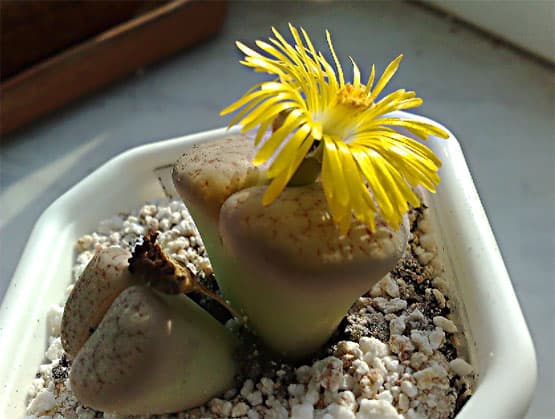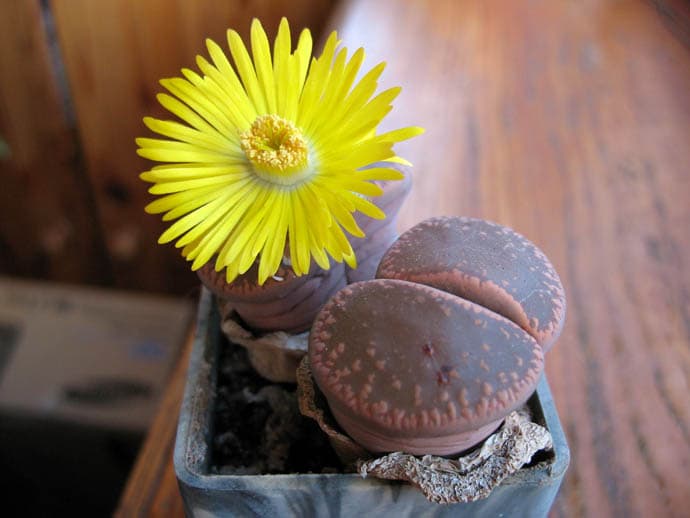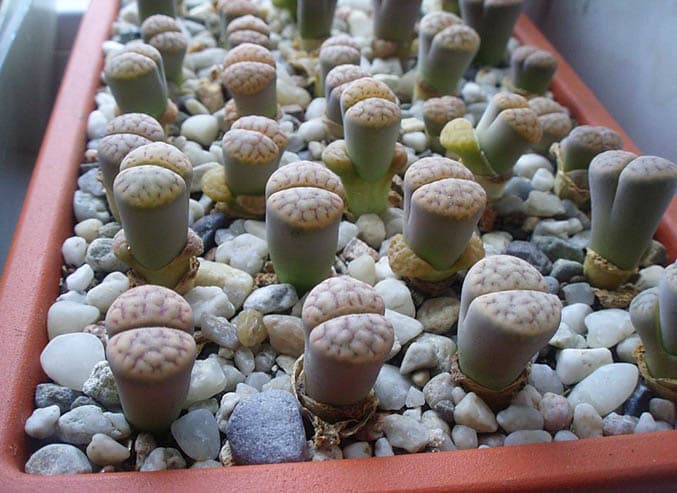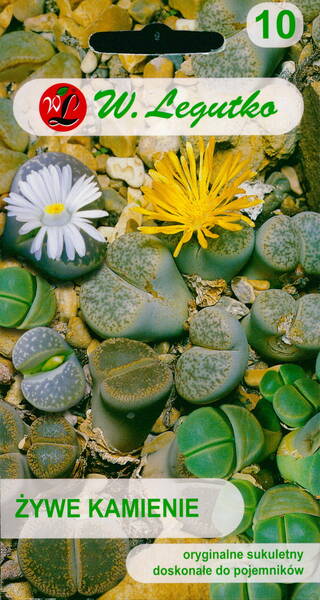Small, stemless, leafy succulents from the Mesembriantemic family. Most of the plant is buried in the soil. Aboveground part - two thick sheets fused into a column up to 20-50 mm high. Its top is dotted with patterns, conical, convex or flat, divided by a gap, from which a peduncle and new leaves appear. Leaves change annually from March to May, while last year's ones dry up. Blossom in July - November, flowers are white or yellow (occasionally orange) 2.5-3 cm in diameter, sometimes fragrant and open in the afternoon. In July - August, the plants rest.
From September to December they begin to grow again. In November-December, the watering of lithops is reduced and stopped, they are kept at a temperature of + 12 + 15 ° C. In late spring, when a couple of new leaves appear. watering is gradually resumed. Lithops do not feed or fertilize cacti at half concentration. They benefit from spraying in the afternoon on hot summer days. After a few years, the plants grow into a whole colony, which is transplanted into a container with good drainage. The substrate is made up of leafy earth and sand in equal parts. They are demanding on lighting, in the spring they are shaded from bright sunlight. Lithops reproduce easily by seeds.
Sowing is carried out in a mixture of peat and sand, sprinkling with sand on top, maintaining a temperature of + 20 ° C. Due to the wide variability of shapes and colours, lithops are of great interest to collectors of indoor plants.

* Lithops are considered to be one of the most unpretentious representatives of "living stones" - but they also require certain care and conditions for good health.
Pots for lithops may not be the widest (the "living stones" grow slowly), but rather deep (due to their deep, voluminous root system). The soil for such plants should be slightly acidic or neutral (pH 5-7), loose (breathable) and necessarily non-hygroscopic (not retaining moisture). Usually, such soil is prepared on the basis of coarse river sand with the addition of garden or forest soil without undecomposed plant residues (1:1) with the addition of pebbles, perlite, crushed brick.
The most unsuitable additives are peat, clay, limestone, soil rich in organic matter. The substrate is pre-sterilized in any case, since in nature these plants live in soils that are not the richest in microflora. At the bottom of the container with "living stones" drainage holes and a drainage layer are required, and the top layer of soil should be fine sand, pebbles or gravel.
Place pots with lithops in the most illuminated place: on the southern or southeastern windowsill (they are not afraid of direct sunlight).
From time to time, the pot should be slightly turned so that the plant does not bend during growth. In winter, additional lighting with phytolamps will not harm the plant, since even at this time the lighting should be bright.
The culture needs to be provided with a comfortable temperature - in summer 20-25 °C, during the dormant period (December-March) - 12-15 °C, but in no case less than + 8 °C.
In the warm season, "living stones" can be placed outdoors. The main thing in caring for lithops is to observe the watering regime, because the plant is extremely afraid of stagnant water in the soil, which will cause it to rot.
During the dormant period, the plants are not watered at all (during this "dry" period, the new leaves that are forming may crack from unnecessary moisture), and watering is resumed only in the spring (around April). Watering should be moderate - usually its need is determined by the turgor of the leaves, which begin to "wrinkle" slightly or become soft when they lack moisture.
In cloudy, cool weather, it is better to completely exclude watering. Water should not get on the leaves of "living stones" and especially in the cracks between them - watering is carried out only in the tray and the soil is always allowed to dry completely between waterings. In the middle of summer, a month-long break in watering is also usually taken - at this time the plant is dormant, as you remember. Watering is resumed around mid-August, and usually ends in October-November before the start of "molting". Lithops are fed 2-3 times, usually in May-June, with a break of 3-4 weeks - with fertilizer for cacti, but with half the recommended dose.
In the same flower pot, even without changing the soil, slow-growing and undemanding to excess nutrition lithops can grow for up to 10 years, so usually replanting is carried out only as the clump grows excessively in width and the roots fill the volume of the old pot (approximately once every 3-4 years, in February-March).
After replanting, the plant is not watered for about a week so that possible microdamage to the roots can heal.


"Flowering stones", "Living stones".













